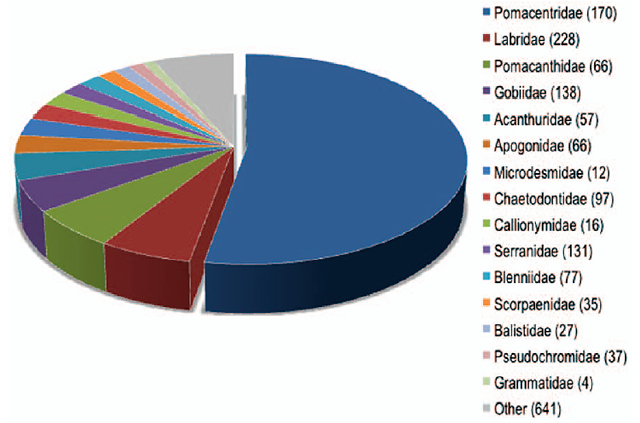
Composition by family of marine aquarium fish imported into the United States. Data for the top 20 families are provided, with the remainder grouped as ‘other’.
The study, Revealing the Appetite of the Marine Aquarium Fish Trade: The Volume and Biodiversity of Fish Imported into the United States, was published yesterday in PLoS ONE by researchers Andrew Rhyne, Michael Tlusty, Pamela Schofield, Les Kaufman, et al. It is an unprecedented detailed investigation of importation records over a one-year period from 2004-2005 and compares invoices and shipping records to discern the total number of both species and individuals imported into the United States.
 Chromis viridis: The #1 imported reef fish. Photo by Andreas Marz
Chromis viridis: The #1 imported reef fish. Photo by Andreas Marz
The researchers documented some very interesting findings:
- 11,003,181 marine fish were imported from 2004-2005.
- 1,802 species total. 125 families total.
- 52% of the imported fish were from only 20 species.
- Ten of the top 20 species were damsels or anemone fishes.
- Wrasses (Labridae) accounted for the most species of any family imported, beating out damselfish/clownfish (Pomacentridae) and gobies (Gobiidae).
- Chromis viridis was both the most common individuals imported as well as the most widely collected species, imported from 29 countries.
- Family Pomacentridae (damselfish and clownfish) comprised half of the top 20 species and almost 3/4 of the individuals.
- Grazing fish such as tangs were imported in surprisingly low relative numbers with the exception of Paracanthurus hepatus (Blue/Regal Tang).
- 86.6% of all imports come from the Philippines and Indonesia (55% and 31% respectively).
- Of the 1,802 species the aquarium trade imported, 33 (1.9%) were introduced to North America native waters, with one (the Indo-Pacific Lionfish) establishing an invasive domestic population.
They also found that “the number of individual fish listed on shipment declarations matched the invoices only 52% of the time and in total, volume was over-reported by 27% as shipments were often mislabeled to contain marine fish” when in reality they contained freshwater fish.
-

- Top 20 marine aquarium fish imported into the United States. * indicate species complexes, which could represent more than one species which are all traded under the same name.
Read the public-access study at PLoS ONE for a dizzying amount of impressive and important data.
“We were pretty stunned by the error rate on those declarations,” Dr. Rhyne said. “Lots of things were being called marine fish that are not marine fish, like goldfish from Thailand. It looked like Singapore and Thailand were shipping a lot of marine fish to the United States, which they’re not. They’re shipping a lot of freshwater fish.”
Ultimately it is hoped that the system utilized by Dr. Rhyne and others in this study could one day prove useful to the United States’ government for more real-time monitoring of marine fish imports. This, in combination with a fast, non-lethal method for screening for cyanide fishing in imported marine fish, could “reduce the risks inherent to the wildlife trade and to protect listed species (CITES). The system could also assist wildlife inspectors with identification of thousands of species from across dozens of phyla.”
(via NYTimes)









0 Comments